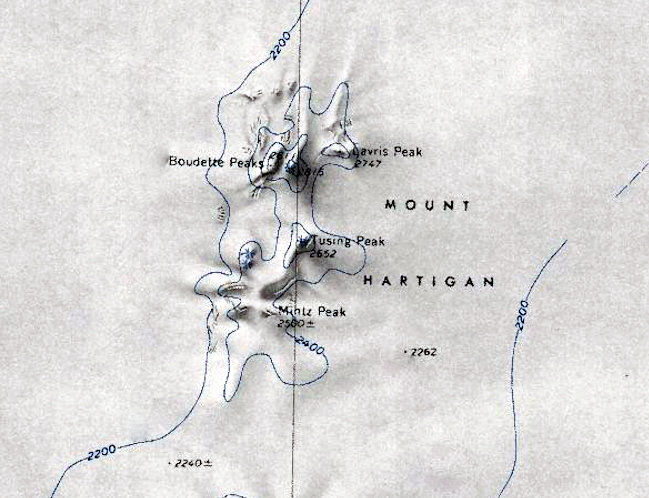Difference between revisions of "Mount Hartigan"
Jump to navigation
Jump to search
Westarctica (talk | contribs) |
m (changed Executive Committee Range to McHenry Range) |
||
| (2 intermediate revisions by one other user not shown) | |||
| Line 1: | Line 1: | ||
[[File:Mount Hartigan.jpg|thumb|Map of Mount Hartigan]] | |||
[[File:Charles C Hartigan USNA.jpg|thumb|Admiral Charles Hartigan, for whom the mountain is named]] | [[File:Charles C Hartigan USNA.jpg|thumb|Admiral Charles Hartigan, for whom the mountain is named]] | ||
'''Mount Hartigan''' is a broad, mostly snow-covered mountain with several individually named peaks which rise up to 2,800 meters. | '''Mount Hartigan''' is a broad, mostly snow-covered mountain with several individually named peaks which rise up to 2,800 meters. | ||
It is situated immediately north of [[Mount Sidley]] in the [[ | It is situated immediately north of [[Mount Sidley]] in the [[McHenry Range]] in [[Westarctica]]. | ||
==Discovery and name== | ==Discovery and name== | ||
| Line 10: | Line 11: | ||
* [[Mintz Peak]] | * [[Mintz Peak]] | ||
* [[Lavris Peak]] | * [[Lavris Peak]] | ||
* Boudette | * [[Boudette Peaks]] | ||
* Tusing Peak | * Tusing Peak | ||
[[Category:Geography of Westarctica]] | [[Category:Geography of Westarctica]] | ||
[[Category:Mountains]] | [[Category:Mountains]] | ||
Revision as of 15:11, 14 January 2025
Mount Hartigan is a broad, mostly snow-covered mountain with several individually named peaks which rise up to 2,800 meters.
It is situated immediately north of Mount Sidley in the McHenry Range in Westarctica.
Discovery and name
Mount Hartigan was discovered by the United States Antarctic Service expedition on a flight on 15 December 1940, and named for Rear Admiral Charles C. Hartigan, U.S. Navy, Navy Department member of the Antarctic Service Executive Committee. Admiral Hartigan had previously received the Medal of Honor for actions during the 1914 United States occupation of Veracruz, Mexico.
Features
- Mintz Peak
- Lavris Peak
- Boudette Peaks
- Tusing Peak

